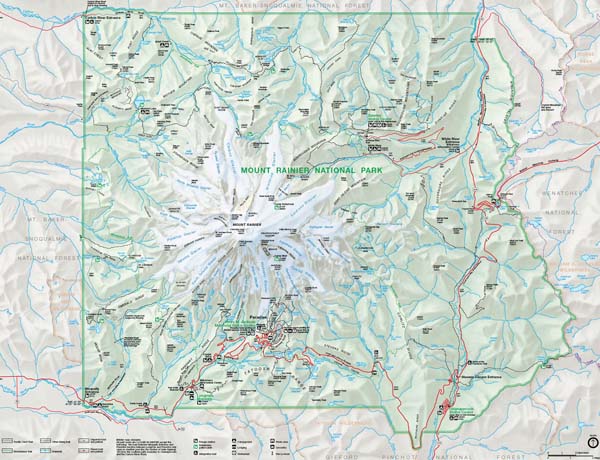Since I took a short break (previous entry here) I found a new project to add to the history work with the Mt. Rainier NP
photo guide. Yes, add it to the list of photo guide
projects and plans already overloaded and somedays overwhelming.
While researching for old maps of Mt. Rainier produced in the decades before and the first decade after the designation as the fifth national park in the US, I found a maps of the NP boundary which was part of the survey to establish the boundary on the ground. As you can see by the work for the first topographic maps by the
USGS, there was a lot of field work.
Old fashioned boots in the forest surveying. This, however, wasn't to determine any elevation points or do any plane-table mapping associated with the topographic map. This was done with survey transit, chain and solar attachment to determine latitude and longitude for establishing the actual boundary with markers.
The designation for the original boundary, described in the
1899 Act was based on the standard township and range established for the
Public Land Survey system for the western part of the US (meets and bounds in the general practice in the eastern part).
The 1899 Act defined the boundary along the lines between sections of the township and range encompassing the new NP. The next task was to survey that on the ground and to establish markers to designate both the NP boundary and corners of the township and range bordering the NP.
The work was entrusted to the General Land Office of the US (federal) government. That office is now part of the Bureau of Land Management (BLM) which manages a lot (yes, hundreds of thousands of acres) in the western US. The new
GLO has put all of the field notes and reports from their archive on the Web.
From their and other Websites in the BLM I found the field notes and reports for the NP Boundary survey work. I am preparing to consolidate them into a single file (PDF) along with a map presenting some of the information. I have just started the work, having downloaded and compiled the on-line copies into a draft PDF and am reading them for completeness and continuity.
During this initial work I realized they did the survey over two summers in 1906 and 1908 but not in a geographical sense of following the soon to be actual boundary, which means the field notes are in chronological order and not geographical order, and the first order of the work is to sort them out in geographical order.
Yeah, you can start to see the work. Surprisingly the notes, from what I've read so far, are really very good on description where you can actually follow their progress on a map along with the distance in chain lengths. New or old maps, it doesn't matter as the terrain hasn't changed very much. There are some differences which seems reasonable because of the time of their work, but nothing to hard to sort out.
Anyway, that's the new work, on top of the old work, and more of lots to do becomes more of more. Yeah, but it's fun and enjoyable, a great way to sit in a cafe with headphones, reading material and a really good topo map. I'll keep you posted on the progress.







